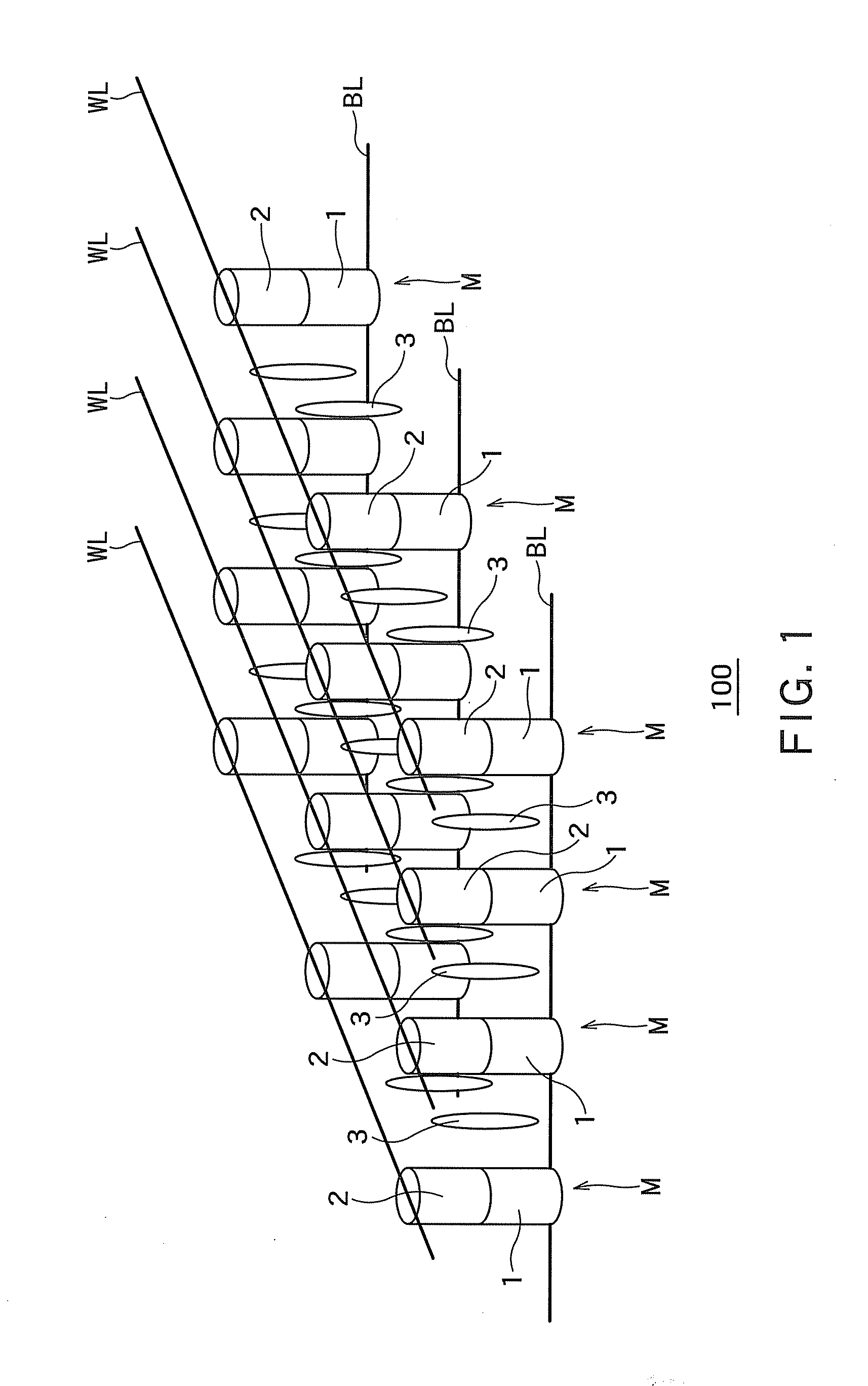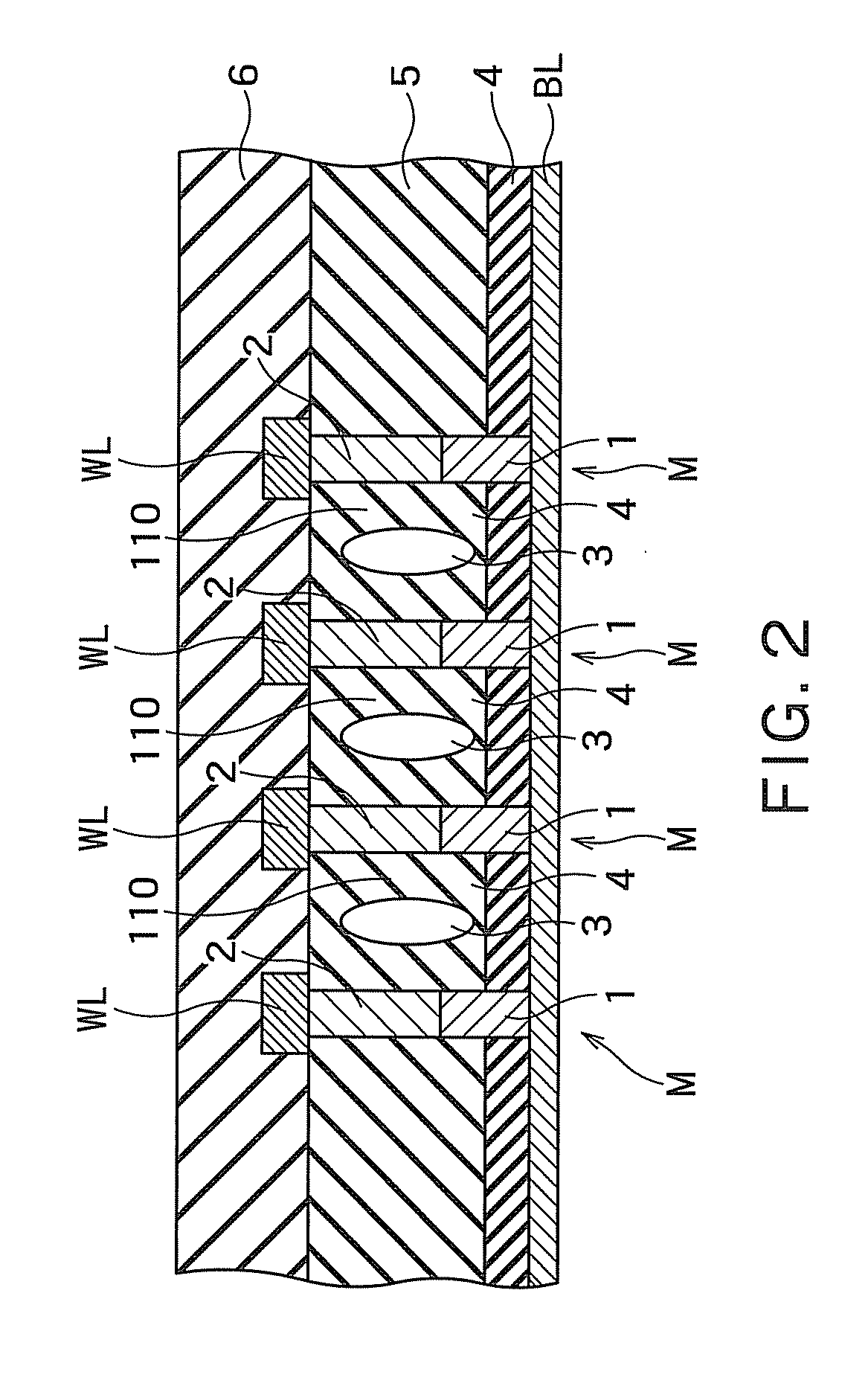Phase-change memory device and method of manufacturing the phase-change memory device
a memory device and phase-change technology, applied in the direction of bulk negative resistance effect devices, semiconductor devices, electrical devices, etc., can solve the problems of data stored in the memory cell, which is not a data write target, and the memory state of each memory cell is affected,
- Summary
- Abstract
- Description
- Claims
- Application Information
AI Technical Summary
Benefits of technology
Problems solved by technology
Method used
Image
Examples
first embodiment
[0067]FIG. 1 is a diagram illustrating a structure in the vicinity of a memory cell region in which a plurality of memory cells M are arranged in a phase-change memory device 100 according to a first embodiment. FIG. 2 is a longitudinal cross-sectional view illustrating a region including the memory cells M arranged along the bit line BL shown in FIG. 1. For convenience, in FIG. 1, the interlayer insulating films shown in FIG. 2 are omitted. In addition, in FIG. 1, the bit lines BL and the word lines WL are briefly shown.
[0068]As shown in FIGS. 1 and 2, the phase-change memory device 100 includes a plurality of bit lines (wiring lines) BL, a plurality of memory cells M, a plurality of word lines (wiring lines) WL, and interlayer insulating films 4, 5, and 6.
[0069]For example, the plurality of bit lines (wiring lines) BL are arranged in parallel to each other on an insulating film (not shown) formed on a semiconductor substrate (not shown).
[0070]The plurality of memory cells M are pr...
second embodiment
[0092]In the first embodiment, an example of the structure for preventing heat generated by the heat source element of a certain memory cell from being transmitted to the phase-change elements of adjacent memory cells has been described.
[0093]In a second embodiment, another example of the structure for preventing heat generated by the heat source element of a certain memory cell being transmitted to the phase-change elements of adjacent memory cells will be described.
[0094]FIG. 6 is a diagram illustrating a structure in the vicinity of a memory cell region in which a plurality of memory cells M are arranged in a phase-change memory device 200 according to the second embodiment. FIG. 7 is a longitudinal cross-sectional view illustrating a region including the memory cells M arranged along the bit lines BL shown in FIG. 6. For convenience, in FIG. 6, the interlayer insulating films shown in FIG. 2 are omitted. In addition, in FIG. 6, bit lines BL and word lines WL are simply presented...
third embodiment
[0117]In the first and second embodiments, an example of the structure for preventing heat generated by the heat source element of a certain memory cell from being transmitted to the phase-change elements of adjacent other memory cells has been described.
[0118]In a third embodiment, still another example of the structure for preventing heat generated by the heat source element of a certain memory cell from being transmitted to the phase-change elements of adjacent other memory cells will be described.
[0119]FIG. 12 is a diagram illustrating a structure in the vicinity of a memory cell region in which a plurality of memory cells M are arranged in a phase-change memory device 300 according to the third embodiment. FIG. 13 is a longitudinal cross-sectional view illustrating a region including the memory cells M arranged along the bit lines BL shown in FIG. 12. For convenience, in FIG. 12, the interlayer insulating films shown in FIG. 13 are omitted. In FIG. 12, bit lines BL and word lin...
PUM
 Login to View More
Login to View More Abstract
Description
Claims
Application Information
 Login to View More
Login to View More - R&D
- Intellectual Property
- Life Sciences
- Materials
- Tech Scout
- Unparalleled Data Quality
- Higher Quality Content
- 60% Fewer Hallucinations
Browse by: Latest US Patents, China's latest patents, Technical Efficacy Thesaurus, Application Domain, Technology Topic, Popular Technical Reports.
© 2025 PatSnap. All rights reserved.Legal|Privacy policy|Modern Slavery Act Transparency Statement|Sitemap|About US| Contact US: help@patsnap.com



